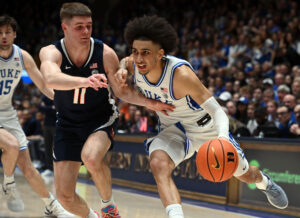The scars left upon Formula 1 after the deaths of Ayrton Senna and Ronald Ratzenburger had not yet healed when the Grand Prix circus rolled up at Imola for the 1995 San Marino Grand Prix: the first time F1 had come to Imola since the sport’s blackest weekend a year previously. A minute of silence was held to mark the first anniversary of the pair’s tragic deaths. In the interests of safety, the flat-out turns at which Senna and Ratzenburger met their maker – Tamburello and Villeneuve – were reconstructed into chicanes with spacious gravel areas surrounding them, but it could be said that, to the motorsport enthusiast, it left the San Marino circuit void of the excitement that the high-speed turns brought it. As well as this, the Rivazza corner – where Rubens Barrichello had his heavy impact in the Friday session in 94 – was altered, along with the Aqua Minerale chicane.
Ferrari fans, still hopeful of a reversal of fortunes after poor performances in the first two races of the season in Brazil and Argentina, were almost treated to a scarlet car on pole position, but Gerhard Berger’s final fast lap of the session proved to be short of Michael Schumacher’s time by just 0.008. The sister Ferrari of Jean Alesi was fifth, behind the two Williams of Damon Hill and David Coulthard. Nigel Mansell, in his first race for McLaren, qualified ninth, three places behind team-mate Mika Hakkinen.
On race day, the usual sunshine that greets a San Marino Grand Prix weekend vanished, and rain fell in the morning. Six of the top ten drivers – including the first five on the grid – opted to start on wet tyres, and they gained five seconds a lap on the rest, but as the laps reached double-figures, the track began to dry and pit stops were made. Schumacher, now on slicks, hit a damp patch on the circuit, sending the car into a twitch, and into the wall on the outside of the entry to the Piratella corner. Such was the bad luck that had befallen Ferrari in recent years, Berger’s engine stalled after his second stop.
Two extra stops for Coulthard were required. After colliding with Alesi in the pitlane, the Scot disengaged the speed limiter too early and was given a ten second stop-and-go penalty, and also for a new front-wing, which was damaged in the collision with Alesi’s Ferrari. These incidents left Hill in the lead, whose race was also nearly scuppered when the fuel hose during his final stop became stuck, but managed to exit the pits just in front of Alesi.
Hill held off Alesi’s charge and took home an emotional victory for the Williams team. Berger, recovering from the stalled engine issues earlier on in the race, completed the podium, and was left to ponder a true ‘what-if’ race. After the race, Hill led the championship by six points from Schumacher, with Williams and Ferrari equal on 23 points in the Constructors’ championship. That season, Michael Schumacher would go on to dominate the championship, winning by thirty-three points.
Thank you for reading. Please take a moment to follow me on Twitter – @jackinho92. Support LWOS by following us on Twitter – @LastWordOnSport and @LWOSworld– and “liking” our Facebook page.
Interested in writing for LWOS? We are looking for enthusiastic, talented writers to join our motorsports writing team. Visit our “Write for Us” page for very easy details in how you can get started today!
Have you tuned into Sports Events Guide Radio? LWOS is pleased to bring you 24/7 sports radio to your PC, laptop, tablet or smartphone. What are you waiting for? GO!





